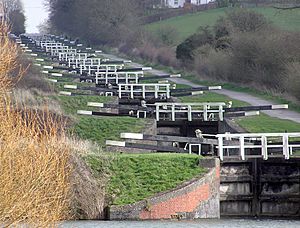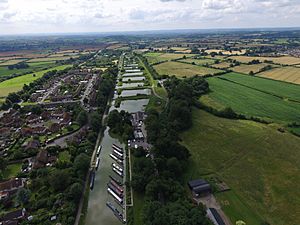Caen Hill Locks facts for kids

Caen Hill Locks are a famous set of 29 locks on the Kennet and Avon Canal. You can find them between the villages of Rowde and Devizes in Wiltshire, England. These locks help boats climb a very steep hill.
What Are Caen Hill Locks?
The 29 locks at Caen Hill climb a total of 237 feet (about 72 meters). This happens over 2 miles (about 3.2 kilometers). It's like climbing a hill with a slope of 1 in 44.
The locks are divided into three main groups:
- The first seven locks are spread out. They go from Foxhangers Wharf Lock to Foxhangers Bridge Lock.
- The next sixteen locks are the most famous part. They form a very steep, straight line up the hillside. This section is so special it's protected as a historic monument.
- The last six locks lead the canal into the town of Devizes.
Because the hill is so steep, the water sections between the locks are very short. To make sure there's enough water, fifteen of these locks have large, wide areas next to them. These are called side pounds. They store extra water. It takes a boat about 5 to 6 hours to go through all the locks.
The areas around the side pounds are important for nature. The Canal & River Trust looks after them. In 2012–13, over 30,000 trees were planted here. This was done to celebrate the Queen Elizabeth II's Diamond Jubilee.
History of the Locks
The Caen Hill Locks were designed by a famous engineer named John Rennie the Elder. They were the last part of the 87-mile (140 km) Kennet and Avon Canal to be finished. The canal connects Bristol and Reading. The locks opened in 1810.
Bricks for the locks were made right next to the site. A brickyard was set up just for this purpose. It continued to make bricks until the mid-1900s. John Blackwell was the person who managed the building work for Rennie.
Before the locks were fully open, a special tramway was used. It carried goods between Foxhangers (at the bottom) and Devizes (at the top). You can still see parts of this old tramway today. They are in the arches of the road bridges over the canal.
For a while, from 1829 to 1843, the locks were even lit up at night. This was done using gas lights.
Later, when railways became popular, people used the canal less. It eventually closed down. The very last cargo to go through the locks was grain in 1948.
Starting in the 1960s, a big effort began to clean and rebuild the canal. This project took many years. In 1990, Queen Elizabeth II officially opened the restored locks. However, boats had been able to use them for several years before that.
The locks use a lot of water to work. To help with this, a special pump was put in at Foxhangers in 1996. This pump can send 7 million gallons (about 26.5 million liters) of water back to the top of the locks every day. That's enough water for one lock every eleven minutes!
In 2010, British Waterways (now the Canal & River Trust) planned to replace sixteen new lock gates. This was part of their winter maintenance. The very cold weather caused delays. Only twelve pairs of gates were replaced by Easter 2010. The old wooden gates were given to the Glastonbury Festival. They were used to build a new bridge there. The bridge was named after Arabella Churchill, one of the festival's founders.
Named Locks
Some of the locks at Caen Hill have special names. These include:
- Lock 42: Monument Lock
- Lock 43: Queen Elizabeth Lock
- Lock 44: Sir Hugh Stockwell Lock
- Lock 45: Cave Lock
- Lock 46: A. P. Herbert Lock
- Lock 47: Manifold Lock
- Lock 48: Trust Lock
- Lock 49: Maton Lock
- Lock 50: Kennet Lock
Restoration Images








